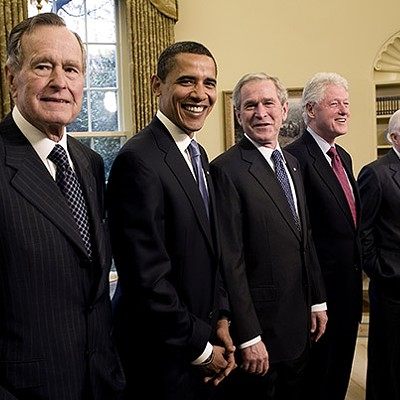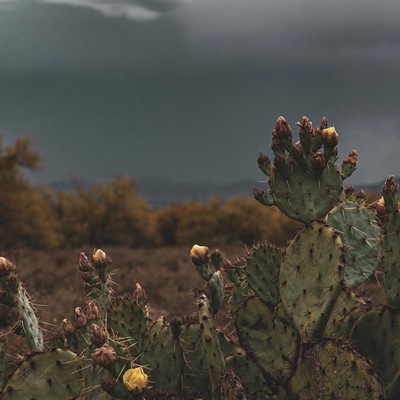Working for the Seattle Arts Commission, Gowin had been flying in chartered planes over the volcanic ruins, shooting pictures of the new plant life just beginning to push through the charred layers. One day, stormy weather kept him from the mountain, so he and the pilot decided to take a side trip to the Hanford Nuclear Reservation.
More than 40 years before, some 30,000 people had lived at this now-abandoned "city." It became a trigger for the atomic bombs that would lay waste to Hiroshima and Nagasaki. The materials used similarly laid waste to the Washington landscape. Flying high above this poisoned land, now scraped bare of human habitation, and the polluted river curving by it, Gowin was at once horrified and entranced.
"Still visible after 40 years were the pathways, burial mounds and waste disposal trenches," Gowin wrote in an introduction to Emmet Gowin: Changing the Earth, his big show now at the Center for Creative Photography. "Etched and carved in the landscape below was a whole history of unconscious traces. The making of the atomic bomb É had also cost the total destruction and poisoning of a landscape and placed a great river, the Columbia, at risk."
Best known before that flight for his groundbreaking pictures of family life and the land in a rural Virginia community, Gowin began shooting photos of Hanford's scarred earth. These images became the first of thousands in a new aerial series that pictures the ways humans have altered--and wounded--their own land. Ninety-two of them are on view at the Center, culled for this fine traveling show by curator Jock Reynolds, director of the Yale University Art Gallery. Golf courses in Japan and Arizona, farmland irrigated by circular "pivot" machines on the Great Plains, craters carved into the Nevada desert by nuclear testing and coal mines stripped into former forests in the Czech Republic: They all make their marks on the earth in Gowin's pictures.
The surprise is that their scars don't make for ugly pictures. Instead, these works have a terrible beauty.
Take the picture "Golf Course Under Construction, Arizona," 1993. Shot from on high, it's an undulating abstraction of blacks, charcoals and whites, full of natural curves and ellipses. There's no horizon line to identify it as a slice of land; the surface is flattened and foreshortened. If you didn't see the title, you might think it was an abstract painting shot in black and white for an art-history textbook, or, alternatively, a picture of toxic liquids incubating insidiously in a chemical bath. That last interpretation is a little closer to the truth--golf courses are notoriously damaging to the land, and in the desert, they suck up extravagant amounts of water--but Gowin gets at this underlying truth through visual metaphor. As Doug Nickel, the new director of the CCP, aptly puts it, Gowin's work "confounds expectations."
Similarly, the pictures of the irrigation pivots have a startlingly scientific look. As any cross-country air traveler has noticed, the pivots draw huge circles on arid lands in the nation's center; this inefficient watering method imposes a human geometry onto the earth's soft curves. Gowin shot his Kansas pictures in winter, when the snow makes white drawings on the farmers' black furrows. But from the sky, these drawings, sketched by man and nature, look like giant radar screens or, as one critic has noticed, like ultrasounds used to detect cancer tumors. "Snow Over Pivot Agriculture Near Liberal, Kansas," 1995, seems to reveal a giant, dark malignancy.
Even the Nevada moonscape, full of unnatural craters blasted by nuclear test bombs (which sickened nearby troops and Nevada residents alike), has an eerie loveliness. "Diagnostic Array for the US/UK Test, Icecap, Suspended 19992, Nevada Test Site," 1996, is a flat, textured composition of lines and circles, lights and shadows.
A photographer could easily reduce this disturbing material to a political lecture, but Gowin's take is more profound than that. Now 61 years old and a professor at Princeton, Gowin makes pictures that take the long view, and not just because they're shot at a great distance from the airplane. He has a rigorous aesthetic, and his works deal not just with contemporary human depredations on the earth, but with the grand sweep of geologic time. These pictures remind viewers that the planet's been here for eons; its hills and mountains have grown over millennia; its rivers have taken years to carve their paths. But it takes just one, short-lived, mid-20th-century trailer court, say, to cut a permanent gash in the desert ("Traffic Pattern, Abandoned Trailer Park, San Carlos Apache Reservation near Globe, Arizona," 1988), and one ill-conceived American plan to drop a nuclear bomb on distant, populous cities to have an ironic and permanent side effect back home: the destruction of a piece of our own land in Washington state.
"Old Hanford City Site and the Columbia River, Hanford Nuclear Reservation Near Richland, Washington," 1986, one of Gowin's first pictures in the series, like the others, is a gorgeously printed toned gelatin silver print. The river snaking through the landscape glows biliously in tones that hint at toxic yellow or pink. The government may have scraped away the houses, whose foundations still pockmark the land, shut down the roads and sent the people away, but the river continues on, bringing in its polluted waters who knows what to God knows where.














